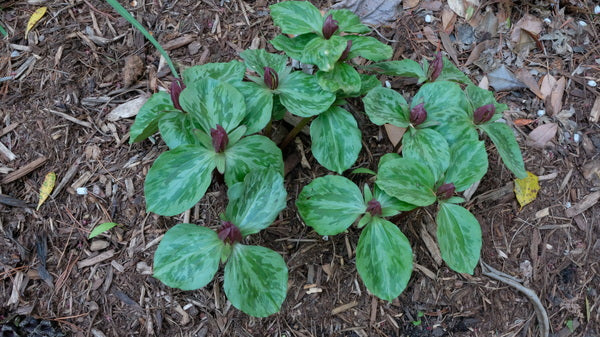
Aconitum carmichaelii 'Autumn Indigo'
The following article is part of a series geared toward entry-level gardeners. For deep dives into a variety of perennials that we have sold over the decades, visit our archive of in-depth perennial articles written by Tony Avent, Dr. Patrick McMillan, and other Plant Delights and JLBG experts. We also have transcripts of our Gardening Unplugged videos, recorded during our Open Nursery and Garden Days, that have great information for gardeners of all experience levels.
Shade perennials are a beautiful and versatile addition to any garden. These plants thrive in areas with limited direct sunlight and can add color and interest to otherwise dull areas of your yard. However, caring for shade perennials requires some knowledge and attention to detail, as different species have unique requirements and preferences. In this article, we will explore the various types of shade perennials, their benefits, and how to grow and care for them to ensure a flourishing and vibrant garden. Whether you are an experienced gardener or just starting out, this guide will provide you with the essential information to cultivate a stunning collection of shade-loving perennials in your outdoor space.
Carex bromoides
Plant Sun Requirements Explained
Part-sun tp shade, light-shade, light-shade to shade, and shade are a few of the sun requirements you may see when shopping for shade plants. Below are the basic definitions for the most common sun requirements that apply to shade perennials. For a more in-depth explanation of all sun conditions with example garden pics, see our plant sun requirements and light conditions page. When selecting shade perennials for your garden, it's important to consider the specific light conditions of your planting area to ensure that you choose plants that will thrive in your garden.
Sun to Light Shade
Indirect filtered light to 6+ hours of direct sun during the day. Plants that prefer cooler conditions benefit from sun in the morning. Plants that love heat prefer the hot afternoon sun.
Sun to light shade plants:
Aconitum carmichaelii 'Autumn Indigo' - Also known as monkshood, this Chinese seed strain of Aconitum carmichaelii forms deer resistant clumps of green foliage topped with helmet-like, lavender flowers.
Ruscus aculeatus 'Wheeler's' - This evergreen butcher's broom has dark-green foliage year-round and is adorned with bright red berries in fall and winter.
Sun to Shade
Tolerant of 6+ hours of direct sun to no direct sunlight during the day.
Parthenocissus quinquefolia 'Monham'
Sun to shade plants:
Carex bromoides - This ornamental grass prefers very wet shade and looks great planted in mass. It's also a host plant for a variety of pollinators.
Parthenocissus quinquefolia 'Monham' - This deciduous vine can climb up to 10' a year and has amazing cream-mottled foliage.
Part Sun
Areas of your garden that receive shade to light shade during most of the day, but get a few hours of direct sun, either in the morning or evening - plants that prefer cooler conditions benefit from sun in the morning and afternoon shade during the heat of the day, while plants that love heat benefit from shade in the morning and prefer to bask in the hot afternoon sun.
Hosta 'Wind beneath My Wings' PP 33,317
Part-sun plants:
Part Sun to Light Shade
Areas that receive a couple of hours of direct sun per day to indirect dappled light throughout the day.
Part-sun to light-shade plants:
Acanthus 'Summer Beauty' - This acancthus hybrid loves our hot, humid North Carolina summers and produces 6' tall scapes of white flowers during the summer.
Acorus gramineus 'Licorice' - A wonderful ornamental grass that makes a superb groundcover and smells like licorice when crushed!
Hosta 'Wind beneath My Wings' - Hosta are a must have for any shade garden and this one is one of our favorites.
Part Sun to Shade
Areas that receive a couple of hours of direct sun per day to dense shade for most of the day.
Polygonatum odoratum 'Variegatum'
Part-sun to shade plants:
Polygonatum odoratum 'Variegatum' - This winter-dormant perennial produces beautifully variegated foliage through underground rhizomes that are topped with white flowers in spring.
Trillium sessile 'Halifax' - We feel trillium has a reputation as being hard to grow but this couldn't be further from the truth. This is a great variety of trillium that can take a little more sun than most.
Light Shade
Light shade occurs where there is a smattering of large and small trees, where indirect rays of light can filter through the canopy of limbs. This can be artificially accomplished by selective removal of trees in a forested area, and through removal of many of the lower tree limbs.
Trillium sessile 'Halifax'
Light-shade plants:
Arachniodes standishii 'Mt. Daisen' - A lacy, elegant fern that forms clumps up to 4' wide.
Trillium sulcatum 'Cumberland' - A heat tolerant, woodland plant with beautiful red flowers in late spring.
Light Shade to Shade
Filtered light to full shade throughout the day.
Light-shade to shade plants:
Aspidistra elatior 'Asahi' - No shade garden is complete without aspidistra and this beautifully variegated variety provides year-round interest.
Aspidistra elatior 'Asahi'
Disporopsis aspersa 'Winter Gem' - This shade plant has glossy evergreen foliage and yellow, lemon-scented flowers in spring, and blue berries in winter. A fantastic addition to the shade garden.
Shade perennials can add color, texture, and interest to any garden, and can thrive in areas with limited direct sunlight. When selecting shade-loving plants, it's important to consider the specific light conditions of your planting area, as different species have unique requirements and preferences. Whether you are looking to fill a shady spot in your garden or create a vibrant shade garden, understanding the various types of shade perennials and how to care for them is essential for a successful and beautiful garden. By following the tips and guidelines outlined in this article, you can create a stunning collection of shade perennials that will thrive in your outdoor space for years to come.

